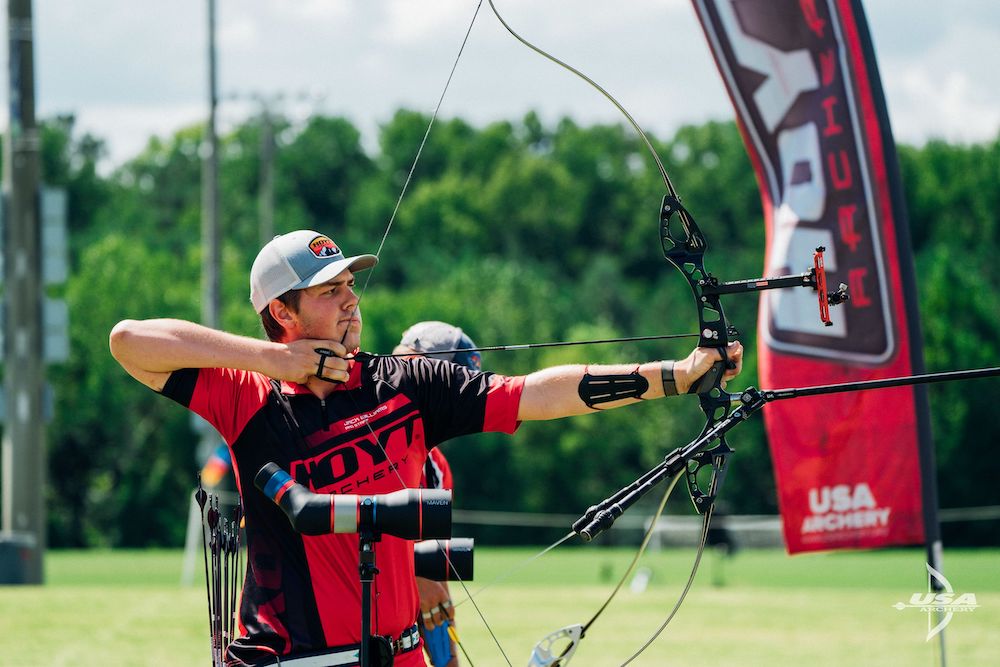Fresh off the Tokyo Olympics, Jack Williams rolled right into another competition at the Hyundai Archery World Cup and World Championships in Yankton, South Dakota, this past September. We talked with him there and he shared his advice on why it’s so important for archers to check their equipment during tournaments.
About Jack

Jack Williams went from competitive fencing to competitive archery and made his Olympic debut in 2021. Photo Credit: USA Archery
Originally a competitive fencer, Williams is now dedicated to archery, ready to give advice to aspiring archers and already thinking ahead to the 2024 Olympics.
“I was a competitive youth fencer for four or five years and then I started getting better at fencing and started doing tournaments: local tournaments, regional tournaments, national tournaments. Then the fencing studio started doing archery,” Williams said. “Priority shifted to doing both. I did archery for fun and still competed for fencing. Then, as that kept going and going, I realized I can’t really do both. It came down to ‘Do you want to do a competitive season for fencing or archery?’ and I chose archery. As I kept getting better, fencing kind of drifted away and I committed completely to archery. I moved down to the training center in Chula Vista when I was 16. That was kind of the beginning of working full time as an archer and being committed, and now the 2020 Olympics has come and gone and now I’m looking forward to the next one and the one after that and keep going.”
Why Is It So Important to Check Your Equipment?
Williams started as many youth archers do, with a Genesis bow, then transitioned to a recurve the same year and has been competing with an Olympic recurve ever since. He discussed why having the right equipment, tuned properly, is so critical to your performance on the line.
“The whole idea of the equipment being so adjustable is that you adjust it to you perfectly,” Williams said. “You make every part of that bow work toward you and help you do whatever it is — whether you’re shooting for super high scores or just having fun, it’s still more fun to shoot with the bow helping you. Everything can get tapped or bumped on that bow. Just like it can be adjusted, it can be unadjusted.” Success in archery relies as much on the equipment as it does on the skill of the archer using it. “Checking things like tiller, brace height, making sure your V-bar angles are the same: Stuff like that is very crucial because it changes a lot of how the bow will act. In some cases, you could lose tens of points by a couple inches with your brace height or tiller being off.”
When Should You Check It?
So, when should an archer check their equipment to make sure it hasn’t gone out of alignment?
“As soon as you set up your bow for the first time, it’s always good to run through the basics: tiller, brace height, kind of make sure everything’s set in place, your limbs are good,” Williams said. “Pull it back and if your V-bar feels weird, your bow is wanting to pull, definitely check out what feels different. As you get better, you can kind of tell even when it changes throughout the day. I can tell when my brace height or my tiller changes based on what’s going on on the target faces.”
What Should You Check First?
OK, so the archer has pulled their bow out of the case and they’re ready to set up; what things should they check first?
“Start with the most adjustable things: brace height and tiller,” Williams said. “If those are on, chances are everything else is still pretty good. Check your clicker position, make sure that didn’t get bumped, and the rest; that stuff wouldn’t just slowly change like a brace height might.” A properly stored bow will also help ensure that these items are as protected as possible. “If things aren’t working and you’re still getting bad scores, you could go back and check your limb alignment and make sure your bow is still in line,” Williams added. He noted that arrows shouldn’t really need to be checked that frequently, but if something specific happens and you know the arrow was likely damaged, check it. For example, Williams said, “If you Robin Hood an arrow and the back is cracked. Watch your nocks — if you’re shooting well enough to where you’re breaking nocks, you’ve got to watch for if they’re starting to crack.”
What to Expect
When you compete in an archery tournament, the officials will perform a check of your equipment, but this is merely to make sure your equipment is adhering to the tournament rules. It’s not a check to make sure your equipment is in tune.
“So, in recurve division, it’s making sure you don’t have a magnified scope, making sure you don’t have a release aid hidden somehow in your fingertips,” Williams said. “Mainly making sure your arrows are named and you’ve got your initials on.”
He noted that it shouldn’t be too hard to make sure your bow is legal to tournament rules. “Most of the equipment on the market will be legal, so just make sure you know that this is a recurve product, this is a compound product,” he said. “You can’t use a compound scope on a recurve.”
Archers need to be prepared to fix any issues that arise while they’re checking their equipment. If they find something out of whack, they need to be able to remedy it immediately, on the spot. Williams advised archers to always carry a set of Allen wrenches. “That goes for all the stuff you use,” he said. “If all your stuff is standard, then all you need is a standard set of Allen wrenches. I would have two because very often one of them just doesn’t show up and you’ve got to still be able to adjust it. If you have even one thing on your bow that’s metric, I would say have a full set of metric, just in case.”
Take Care of Your Equipment
Archery equipment is fairly resilient, but it has its limits. Make sure you place your equipment in protective cases to minimize, and hopefully eliminate, damage. Make sure you check your equipment after travel to make sure nothing happened to it during the journey.
“Take care of it, don’t beat it up too much,” he said. “This stuff is pretty durable, but you still can’t beat it up. It’s made to be shot, it’s made to be used, but put it back in the case and use limb sleeves and sight boxes to make sure stuff doesn’t get bumped or shifted and break.” Williams noted that one of the most important things is to make sure the equipment is working for you.
Learning the ins and outs of your equipment is an important part of the archery process. It will help you in the long run to know how to perform a quick tune of your equipment. As you gather more experience, you’ll be able to spot the signs that something is off much more quickly. Don’t hesitate to reach out to other archers for help anytime you’re unsure. Archery is a community, and there are plenty of community members ready to help you achieve archery success.
Ready to get started? Visit our store locator to find an archery range near you.



